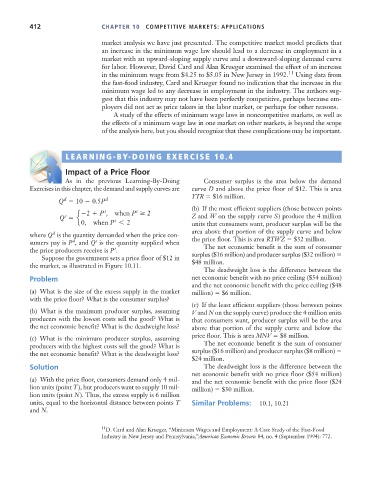Page 438 - Microeconomics, Fourth Edition
P. 438
c10competitive markets applications.qxd 7/15/10 4:58 PM Page 412
412 CHAPTER 10 COMPETITIVE MARKETS: APPLICATIONS
market analysis we have just presented. The competitive market model predicts that
an increase in the minimum wage law should lead to a decrease in employment in a
market with an upward-sloping supply curve and a downward-sloping demand curve
for labor. However, David Card and Alan Krueger examined the effect of an increase
in the minimum wage from $4.25 to $5.05 in New Jersey in 1992. 11 Using data from
the fast-food industry, Card and Krueger found no indication that the increase in the
minimum wage led to any decrease in employment in the industry. The authors sug-
gest that this industry may not have been perfectly competitive, perhaps because em-
ployers did not act as price takers in the labor market, or perhaps for other reasons.
A study of the effects of minimum wage laws in noncompetitive markets, as well as
the effects of a minimum wage law in one market on other markets, is beyond the scope
of the analysis here, but you should recognize that these complications may be important.
LEARNING-BY-DOING EXERCISE 10.4
S
D
E
Impact of a Price Floor
As in the previous Learning-By-Doing Consumer surplus is the area below the demand
Exercises in this chapter, the demand and supply curves are curve D and above the price floor of $12. This is area
YTR $16 million.
d
d
Q 10 0.5P
(b) If the most efficient suppliers (those between points
s
s
2 P , when P 2
s Z and W on the supply curve S) produce the 4 million
Q e s
0, when P 6 2 units that consumers want, producer surplus will be the
d
where Q is the quantity demanded when the price con- area above that portion of the supply curve and below
s
d
sumers pay is P , and Q is the quantity supplied when the price floor. This is area RTWZ $32 million.
The net economic benefit is the sum of consumer
the price producers receive is P . s
Suppose the government sets a price floor of $12 in surplus ($16 million) and producer surplus ($32 million)
the market, as illustrated in Figure 10.11. $48 million.
The deadweight loss is the difference between the
Problem net economic benefit with no price ceiling ($54 million)
and the net economic benefit with the price ceiling ($48
(a) What is the size of the excess supply in the market million) $6 million.
with the price floor? What is the consumer surplus?
(c) If the least efficient suppliers (those between points
(b) What is the maximum producer surplus, assuming V and N on the supply curve) produce the 4 million units
producers with the lowest costs sell the good? What is that consumers want, producer surplus will be the area
the net economic benefit? What is the deadweight loss? above that portion of the supply curve and below the
price floor. This is area MNV $8 million.
(c) What is the minimum producer surplus, assuming
producers with the highest costs sell the good? What is The net economic benefit is the sum of consumer
the net economic benefit? What is the deadweight loss? surplus ($16 million) and producer surplus ($8 million)
$24 million.
Solution The deadweight loss is the difference between the
net economic benefit with no price floor ($54 million)
(a) With the price floor, consumers demand only 4 mil- and the net economic benefit with the price floor ($24
lion units (point T ), but producers want to supply 10 mil- million) $30 million.
lion units (point N). Thus, the excess supply is 6 million
units, equal to the horizontal distance between points T Similar Problems: 10.1, 10.21
and N.
11 D. Card and Alan Krueger, “Minimum Wages and Employment: A Case Study of the Fast-Food
Industry in New Jersey and Pennsylvania,”American Economic Review 84, no. 4 (September 1994): 772.

